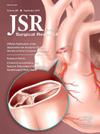Association of Perioperative Vasodilator Therapy and Mortality in Nonocclusive Mesenteric Ischemia
IF 1.7
3区 医学
Q2 SURGERY
引用次数: 0
Abstract
Introduction
Nonocclusive mesenteric ischemia (NOMI) is a life-threatening condition characterized by mesenteric hypoperfusion without arterial occlusion and is associated with a high mortality rate. Although vasodilator therapy is recommended in clinical guidelines, its effectiveness in surgical cases of NOMI remains unclear. In this study, we aimed to evaluate the effectiveness of perioperative vasodilator therapy in patients undergoing surgery for NOMI, using a nationwide real-world database in Japan.
Methods
A retrospective cohort study was conducted using data from 2014 to 2024. Patients who underwent surgery for NOMI were included and categorized into a vasodilator group (those who received prostaglandin E1 or papaverine hydrochloride within 1 d before or after surgery) and a nonvasodilator group. Inverse probability of treatment weighting with stabilized weights was applied to adjust for baseline differences. The primary outcome was 30-d mortality. Secondary outcomes included in-hospital mortality, reoperation proportion, and complication proportion.
Results
A total of 702 patients were analyzed (86 in the vasodilator group and 616 in the nonvasodilator group). After inverse probability of treatment weighting, baseline characteristics were well balanced. The vasodilator group showed significantly lower 30-d mortality (weighted hazard ratio, 0.44; 95% confidence interval (CI), 0.22-0.88) and in-hospital mortality (weighted risk ratio, 0.62; 95% confidence interval, 0.40-0.96). Reoperation and complication proportions did not differ significantly between the groups.
Conclusions
Perioperative vasodilator therapy was associated with reduced mortality in patients undergoing surgery for NOMI. These findings suggest that vasodilator therapy may serve as a beneficial adjunct in the surgical management of NOMI.
非闭塞性肠系膜缺血围手术期血管扩张剂治疗与死亡率的关系。
简介:非闭塞性肠系膜缺血(NOMI)是一种危及生命的疾病,其特征是肠系膜灌注不足,无动脉闭塞,死亡率高。尽管在临床指南中推荐血管扩张剂治疗,但其在NOMI手术病例中的有效性尚不清楚。在这项研究中,我们的目的是评估围手术期血管扩张剂治疗对接受NOMI手术的患者的有效性,使用日本全国真实世界的数据库。方法:采用2014 - 2024年的回顾性队列研究。接受手术治疗的NOMI患者被纳入并分为血管扩张剂组(术前或术后1 d内接受前列腺素E1或盐酸罂粟碱治疗的患者)和非血管扩张剂组。使用稳定权重的治疗加权逆概率来调整基线差异。主要终点为30天死亡率。次要结局包括住院死亡率、再手术比例和并发症比例。结果:共分析702例患者(血管扩张剂组86例,非血管扩张剂组616例)。在处理加权逆概率后,基线特征得到了很好的平衡。血管扩张剂组30天死亡率(加权风险比0.44;95%可信区间(CI) 0.22-0.88)和住院死亡率(加权风险比0.62;95%可信区间0.40-0.96)显著降低。两组再手术及并发症比例无明显差异。结论:围手术期血管扩张剂治疗与NOMI手术患者死亡率降低相关。这些发现表明,血管扩张剂治疗可能是外科治疗NOMI的有益辅助手段。
本文章由计算机程序翻译,如有差异,请以英文原文为准。
求助全文
约1分钟内获得全文
求助全文
来源期刊
CiteScore
3.90
自引率
4.50%
发文量
627
审稿时长
138 days
期刊介绍:
The Journal of Surgical Research: Clinical and Laboratory Investigation publishes original articles concerned with clinical and laboratory investigations relevant to surgical practice and teaching. The journal emphasizes reports of clinical investigations or fundamental research bearing directly on surgical management that will be of general interest to a broad range of surgeons and surgical researchers. The articles presented need not have been the products of surgeons or of surgical laboratories.
The Journal of Surgical Research also features review articles and special articles relating to educational, research, or social issues of interest to the academic surgical community.

 求助内容:
求助内容: 应助结果提醒方式:
应助结果提醒方式:


